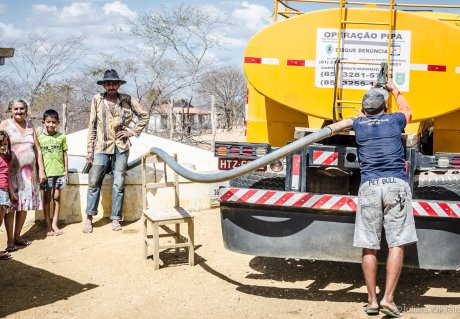
Project
A key towards drought preparedness in northeast Brazil (PhD project - Louise Cavalcante de Souza Cabral)
The goal is to understand how policies have developed over time, and how it has affected the dissemination of drought impacts locally. I use theoretical lenses to support the understanding of policy changes. They helped me understand the role of ideas in policy making, and describe the combination of actors, timing and solutions to deal with drought-related challenges. What I find exciting is the comprehension of policy decisions on farmers' ability to deal with drought impacts, and the role of these decisions on the dynamics of the built environment.
Background
Droughts are common in the northeast region of Brazil. The region is drought-prone, and has historically faced drought events with records since the sixteenth century. The most recent drought from 2012 to 2018 devastated livestock- and crop producers, damaged regional economies, and led to widespread water scarcity. This recent event proved that heavy investments in dams and water transfers were not enough to absorb drought impacts. The event also raised attention to improving coordination and institutionalization of drought preparedness, such as the establishment of the northeast drought monitor. Therefore, human influences on drought must be better understood, to manage drought better. Current frameworks for drought monitoring and water accounting focus on the natural boundary conditions. Therefore, they offer little help distilling human influences on drought, such as the role of policy decisions in drought management.
Description
Together with two PhDs and one post-doc, this research is part of a major project called ‘Diagnosing drought for dealing with drought in 3D’. It combines insights from socio-hydrology and water management to build a toolbox for increasing actors' drought preparedness in water and climate governance. This study is conducted in the Northeast of Brazil, with a focus on the Ceará State.
I’m contributing to this toolbox by building bridges between different actors' perspectives about drought management to develop context-specific and actionable knowledge to address drought impacts in the northeast region of Brazil.
By document analysis and interviews with stakeholders, such as farmers and civil servants, I collected qualitative data to answer this research question: How did public policies in Brazil develop towards drought preparedness, and how has this affected the dissemination of drought impacts locally?
My research contributes to socio-hydrology-, public administration and policy fields. I argue that policy decisions are part of human-water interactions, which are shaped and evolve with values, norms, beliefs, and formal rules. Therefore, paying attention to policy decisions is important for understanding phenomena arising from the interactions between human-water systems.
Results
With a Brazilian case, we bring insights into the role of policy paradigms and policy decisions as drivers of interactions in human-water systems. We show how two policy paradigms gradually evolved and influenced drought policy responses in the Brazilian context. Two competing policy paradigms have influenced the regional development of Northeast region: fight-against-drought and cope-with-drought. The first is an ideology of dominance of nature, whereby conquering the environment with water infrastructure mitigates drought impacts. Whereas the cope paradigm represents a proactive attitude toward nature, seeking to adapt to the environmental and climatic context (Cavalcante et al., 2022). We presented the role of cisterns, a rain water harvesting (RWH), on promoting adaptive capacity through social learning to small holder farmers by zooming in to the cope-with-drought paradigm (Cavalcante et al., 2020).
Publications
- Cavalcante, L., Dewulf, A., & van Oel, P. (2022). Fighting against, and coping with, drought in Brazil: two policy paradigms intertwined. Regional Environmental Change, 22(4).
- Cavalcante, L., Mesquita, P., & Rodrigues-Filho, S. (2020). Second Water Cisterns: Social technologies promoting adaptive capacity to Brazilian family farmers. Desenvolvimento e Meio Ambiente, 55.
- Walker, D. W., Cavalcante, L., Kchouk, S., Ribeiro Neto, G. G., Dewulf, A., Gondim, R. S., Martins, E. S. P. R., Melsen, L. A., de Souza Filho, F. D. A., Vergopolan, N., & van Oel, P. R. (2022). Drought Diagnosis: What the Medical Sciences Can Teach Us. Earth’s Future, 10(4).
